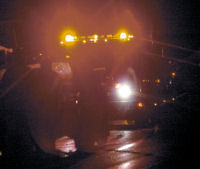| Carbon County emergency response teams work as night falls after a fatal accident claimed the life of a West Valley City man in November on U.S. Highway 6. Three fatalities occurred in Carbon County last year. A total of 16 traffic accident fatalities occurred on U.S. 6 during 2005. |
U.S. Highway 6 claimed 16 lives last year, more than any roadway of its kind in the state.
According to a report released by the Utah Department of Transportation and the Utah Department of Public Safety, the preliminary report indicates that the total number of fatalities on state roads was 225 in 2005.
An additional 57 fatalities occurred on other roads for a total of 282 statewide.
The numbers were released along with a new educational campaign to reduce traffic-related deaths in 2006.
“Should we be happy that 282 people died on Utah roads last year, instead of 373 deaths five years ago?” asked Carlos Braceras, deputy director for UDOT. “Obviously not. We won’t be happy until there are zero fatalities on our roads. We have come together to support this goal of zero fatalities, but the greatest support in this campaign must come from every individual who gets behind the wheel.”
Two highways had higher numbers of fatalities than U.S. 6, Interstate 15 with 67 and Interstate 80 with 17 fatalities. Close behind U.S. 6 were Interstate 84, with 14 fatalities, U.S 89 with 13 and Interstate 70 with 11.
U.S. 191 and Utah Highway 31 were the only other highways which cross the Castle Valley where fatalities were reported. Highway 191 was reported as the site of seven fatalities, while one occurred on Highway 31.
While a variety of factors played a role in fatalities across the state, UDOT officials pointed at seat belts and other restraints as one area that individual drivers could make improvements.
Of three fatalities in Carbon County last year, restraints was determined to be a factor in one death.
Salt Lake County saw more fatalities than anywhere in the state, reporting 62 for the year. Other counties with high numbers of fatalities included Box Elder, 30; Utah, 20; Weber, 20; Tooele, 15; Juab, 14; Washington, 14; and Millard, 12.
Carbon ranked 18th statewide. Neighboring Emery, Duchesne and Grand counties ranked higher with eight fatalities each.
Uintah County was also higher, with four, while Sanpete County had one.
Officials cited nine types of fatalities across the state. Improper restraint led with 208 fatalities, almost triple any other category.
“We will do everything we can to help reduce the number of fatalities on the highways,” said Col. Scott Duncan of the Utah Highway Patrol. “Our blitzes to crack down on DUIs and seat belt violations, along with driver education will help decrease fatalities, but we need the support of every driver in order to reach our goal.”
At the release of the figures, officials also announced an education campaign.
The Zero Fatalities campaign aims to reduce some of the more prevalent contributing factors to fatalities.
Driving under the influence of an intoxciant accidents accounted for 21 fatalities. But officials noted that more people died as a result of fatigue, totaling 25 individuals. Officials recognized fatigue as an area where education may help motors understand the dangers of driving while drowsy.
Five entities, including UDOT, the Utah Department of Public Safety, the Federal highway Administration, AAA and the Federal Motor Carrier Safety Administration, all pledged their support for the campaign.
Many individuals point to external factors as contributing to accidents. However, the report noted that external factors could be ruled out in many cases.
The report showed that 179 fatalities or 63 percent occurred during daylight hours while 92 occurred at night. in 11 cases, the time of day was unknown.
Similarly, road conditions were ruled out in many cases. Dry roads were reported in 233 fatal crashes or 83 percent. In 37 cases, reports indicated snowy or wet conditions, with 12 unknown.
As many people travel on holidays, officials reported the total for holiday weekends. Across the state, nine fatalities occurred on the July 4 weekend. Seven occurred over Memorial Day weekend. Five occurred over New Years. Pioneer Day weekend saw four fatalities, as did Thanksgiving. Three motorists were killed over labor day weekend and two lost their lives the weekend of Christmas Day.
Though interstate highways had more fatalities than federal or state highways, nearly 66 percent of fatal incidents occurred in rural areas. Just over 30 percent occurred in urban areas, with almost 4 percent undefined.
The report indicated that 186 of the fatalities in the state were male while 96 were female.
An age breakdown showed a slightly higher incidence of fatalities among individuals in their 20s, accounting for 25 percent of fatalities. Individuals ages 46 to 65 accounted for 23 percent while 15 percent of fatalities were age 65 or older. Other age groups reported included ages 30 to 45, with 16 percent; ages 16-19, with nine percent; and 12 percent under age 16 or unspecified.
Officials noted that while any death is tragic, the total number of fatalities across the state has declined over the past five years. In 2000, the state reported 373 fatalities. In 2001, that figure dropped to 292, but rose again in 2002 to 329. Since then, it has steadily declined to 309 in 2003, 296 in 2004 and 282 last year.

